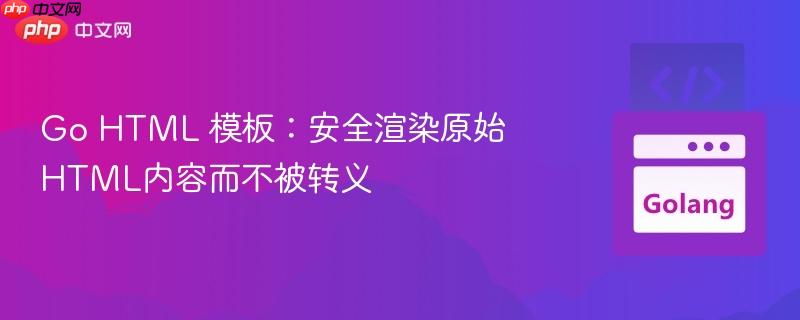
html/template 包是 go 语言标准库中用于生成 html 输出的强大工具。为了增强安全性,它默认会对所有通过管道(pipeline)插入到 html 模板中的数据进行自动转义。这意味着,如果你的数据中包含 <、>、&、" 等 html 特殊字符,它们会被转换为对应的 html 实体(例如,< 变为
然而,在某些场景下,我们可能需要渲染已经确定是安全的、包含原始 HTML 标记的内容。例如,从可信源获取的富文本内容,或者由后端生成的已知安全片段。在默认的转义机制下,这些原始 HTML 会被错误地转义,导致在浏览器中显示为纯文本而非预期的 HTML 结构。
考虑以下 Go 代码和 HTML 模板示例,它从 RSS 源获取新闻描述并尝试在网页上显示:
Go 代码片段(main.go):
package main
import (
"fmt"
"html/template"
"log"
"net/http"
)
// Item 结构体,Description 字段目前是 string 类型
type Item struct {
Title string
Link string
Description string // 假设此字段可能包含原始HTML
}
func handler(w http.ResponseWriter, r *http.Request) {
// 模拟从RSS源获取的数据
data := struct {
ItemList []Item
}{
ItemList: []Item{
{
Title: "Go Template Example",
Link: "http://example.com",
// 这是一个包含原始HTML的Description字段
Description: "<p>This is a <b>rich text</b> description with <i>HTML tags</i>.</p>",
},
{
Title: "Another Article",
Link: "http://another.com",
Description: "Regular text description.",
},
},
}
tmpl, err := template.ParseFiles("index.html")
if err != nil {
http.Error(w, err.Error(), http.StatusInternalServerError)
return
}
if err := tmpl.Execute(w, data); err != nil {
http.Error(w, err.Error(), http.StatusInternalServerError)
}
}
func main() {
http.HandleFunc("/", handler)
fmt.Println("Server listening on :8080")
log.Fatal(http.ListenAndServe(":8080", nil))
}HTML 模板文件(index.html):
立即学习“前端免费学习笔记(深入)”;
<!DOCTYPE html>
<html>
<head>
<title>News Feed</title>
</head>
<body>
<h1>Latest News</h1>
{{range .ItemList}}
<div class="news-item">
<h2><a href="{{.Link}}">{{.Title}}</a></h2>
<p>{{.Description}}</p>
</div>
{{end}}
</body>
</html>当运行上述代码时,Description 字段中的原始 HTML 标记(如 <p>, <b>, <i>)会被转义,导致浏览器渲染时显示为字面量字符串,而不是格式化的 HTML。例如,<p>This is a <b>rich text</b> description...</p> 会在页面上显示为
This is a rich text description...
。为了指示 html/template 包某个字符串是安全的,不应被转义,我们需要将其类型明确声明为 template.HTML。template.HTML 是 html/template 包提供的一个特殊类型,它告诉模板引擎该字符串内容已经被验证为安全,可以直接插入到 HTML 输出中。
要解决上述问题,只需修改 Go 结构体中包含原始 HTML 的字段类型:
修改结构体字段类型: 将 Item 结构体中的 Description 字段从 string 类型更改为 template.HTML。
// Item 结构体,Description 字段现在是 template.HTML 类型
type Item struct {
Title string
Link string
Description template.HTML // 将类型改为 template.HTML
}创建 template.HTML 实例: 在 Go 代码中为 Description 字段赋值时,需要将字符串显式转换为 template.HTML 类型。
data := struct {
ItemList []Item
}{
ItemList: []Item{
{
Title: "Go Template Example",
Link: "http://example.com",
// 将字符串转换为 template.HTML
Description: template.HTML("<p>This is a <b>rich text</b> description with <i>HTML tags</i>.</p>"),
},
{
Title: "Another Article",
Link: "http://another.com",
Description: template.HTML("Regular text description."), // 即使是纯文本,也可以使用
},
},
}注意: HTML 模板文件 (index.html) 无需进行任何修改。模板引擎会根据传入的数据类型自动识别 template.HTML 并进行相应的处理。
以下是修改后的完整 Go 代码和 HTML 模板,展示了如何正确地在 Go HTML 模板中渲染原始 HTML 内容。
Go 代码(main.go):
package main
import (
"fmt"
"html/template" // 导入 html/template 包
"log"
"net/http"
"io/ioutil"
"encoding/xml" // 用于解析RSS数据
)
// RSS 结构体,匹配RSS XML的根元素
type RSS struct {
XMLName xml.Name `xml:"rss"`
Items Channel `xml:"channel"`
}
// Channel 结构体,匹配RSS XML的channel元素
type Channel struct {
XMLName xml.Name `xml:"channel"`
ItemList []Item `xml:"item"`
}
// Item 结构体,包含新闻条目的信息
type Item struct {
Title string `xml:"title"`
Link string `xml:"link"`
Description template.HTML `xml:"description"` // 关键修改:使用 template.HTML
}
func main() {
// 模拟从Google News RSS获取数据
res, err := http.Get("http://news.google.com/news?hl=en&gl=us&q=samsung&um=1&ie=UTF-8&output=rss")
if err != nil {
log.Fatalf("Failed to fetch RSS: %v", err)
}
defer res.Body.Close()
asText, err := ioutil.ReadAll(res.Body)
if err != nil {
log.Fatalf("Failed to read RSS body: %v", err)
}
var rssData RSS
err = xml.Unmarshal(asText, &rssData)
if err != nil {
log.Fatalf("Failed to unmarshal RSS: %v", err)
}
http.HandleFunc("/", func(w http.ResponseWriter, r *http.Request) {
handler(w, r, rssData.Items)
})
fmt.Println("Server listening on :8080")
log.Fatal(http.ListenAndServe(":8080", nil))
}
func handler(w http.ResponseWriter, r *http.Request, channelData Channel) {
tmpl, err := template.ParseFiles("index.html")
if err != nil {
http.Error(w, fmt.Sprintf("Error parsing template: %v", err), http.StatusInternalServerError)
return
}
if err := tmpl.Execute(w, channelData); err != nil {
http.Error(w, fmt.Sprintf("Error executing template: %v", err), http.StatusInternalServerError)
}
}HTML 模板文件(index.html):
立即学习“前端免费学习笔记(深入)”;
<!DOCTYPE html>
<html>
<head>
<title>RSS News Feed</title>
<style>
body { font-family: Arial, sans-serif; margin: 20px; }
.news-item { border: 1px solid #eee; padding: 15px; margin-bottom: 15px; border-radius: 5px; }
.news-item h2 { margin-top: 0; }
.news-item p { line-height: 1.6; }
</style>
</head>
<body>
<h1>Latest News from RSS</h1>
{{range .ItemList}}
<div class="news-item">
<h2><a href="{{.Link}}">{{.Title}}</a></h2>
{{/* Description 字段将作为原始HTML被渲染 */}}
<p>{{.Description}}</p>
</div>
{{end}}
</body>
</html>现在,当运行此程序并在浏览器中访问 http://localhost:8080 时,Description 字段中的内容将作为原始 HTML 被渲染,而不再被转义。例如,如果 Description 包含表格或图片标签,它们将正常显示。
在 Go 语言的 html/template 中,默认的 HTML 转义是出于安全考虑,旨在防止 XSS 攻击。然而,当需要渲染已知安全的原始 HTML 内容时,可以通过将对应的数据字段类型声明为 template.HTML 来绕过自动转义。这一机制提供了一种灵活且安全的方式来处理富文本内容,但开发者必须牢记 template.HTML 意味着对内容的信任,因此务必确保其来源的安全性,对用户输入进行严格净化。
以上就是Go HTML 模板:安全渲染原始HTML内容而不被转义的详细内容,更多请关注php中文网其它相关文章!

HTML怎么学习?HTML怎么入门?HTML在哪学?HTML怎么学才快?不用担心,这里为大家提供了HTML速学教程(入门课程),有需要的小伙伴保存下载就能学习啦!

Copyright 2014-2025 https://www.php.cn/ All Rights Reserved | php.cn | 湘ICP备2023035733号